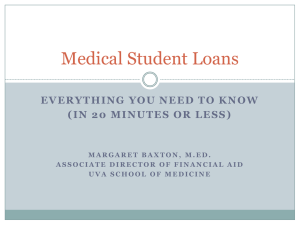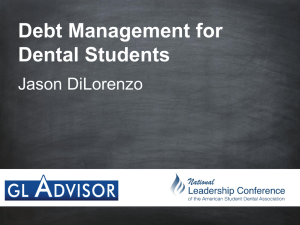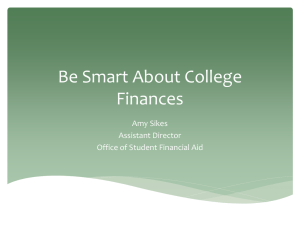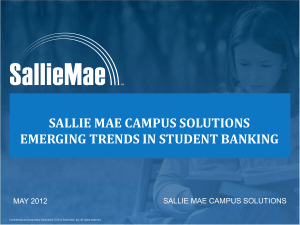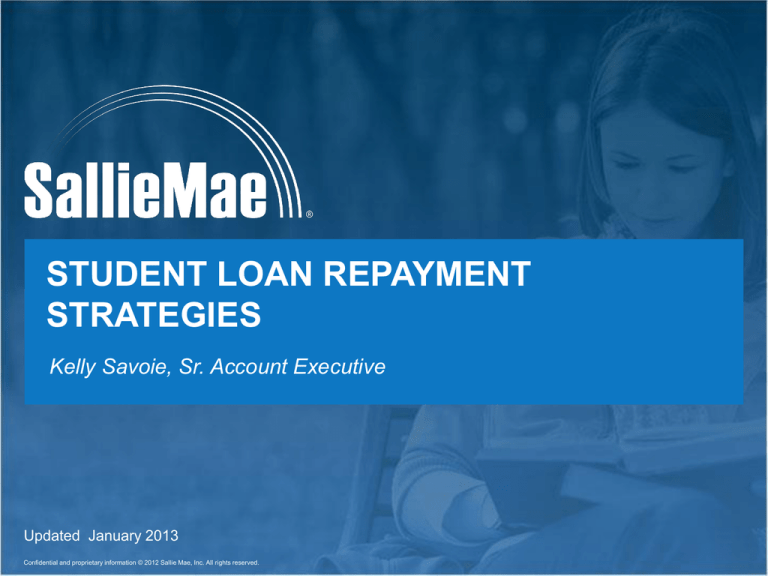
STUDENT LOAN REPAYMENT
STRATEGIES
Kelly Savoie, Sr. Account Executive
Updated January 2013
Confidential and proprietary information © 2012 Sallie Mae, Inc. All rights reserved.
1
Important Things to Know
►
Know your loan portfolio – loan types and relative cost
►
Know your deferment and forbearance options
►
Know the decision points and keep a calendar
►
Know the cost before choosing a repayment plan
►
Know your available resources
►
Stay abreast of changes that might impact your loans
2
Confidential and proprietary information © 2012 Sallie Mae, Inc. All rights reserved.
Know Your Loan Portfolio
►
Know what types of loans you have
Perkins Loans
Federal Stafford Loans
• Direct Loans
• FFELP Loans
• Put Loans
Private/Alternative Loans
►
Identify your servicers
Who do I pay?
3
Confidential and proprietary information © 2012 Sallie Mae, Inc. All rights reserved.
Identify Your Servicers
►
►
Federal and/or private loans may not all be with one servicer
Buying and Selling of Students Loans:
Original lender may have sold a student’s loan
This means a student has a new loan “holder” and/or “servicer”
For example, a FFEL loan may have been sold to the Department
of Education who now holds the loan and is having it serviced by
one of its federal loan servicers such as:
•
•
•
•
•
Direct Loan Servicing Center (ACS)
Great Lakes
Nelnet
FedLoan Servicing (PHEAA)
Sallie Mae
Borrowers must be notified if the service provider of loan
changes
The terms of a federal loan, as specified in the promissory note,
will not change if sold or transferred to another servicer
Confidential and proprietary information © 2012 Sallie Mae, Inc. All rights reserved.
4
Finding Your Federal Student Loans
National Student Loan Data System
www.nslds.ed.gov
Provides data on federal student loans; any Stafford, Grad PLUS,
Consolidation or Perkins Loans should be listed in this central database
Confidential and proprietary information © 2012 Sallie Mae, Inc. All rights reserved.
5
Subsidized vs. Unsubsidized Stafford Loans
Subsidized Loans
Have no interest cost while student
is in school, in grace (if applicable),
or in a period of authorized
deferment
EXAMPLES
►
►
►
►
►
Subsidized Stafford Loans*
Perkins Loans
Consolidation Loans- portion of
underlying eligible subsidized loans
Primary Care Loans
Some institutional loans (see
promissory note or aid office)
Unsubsidized Loans
Borrower is responsible for interest
that accrues from the time of
disbursement
EXAMPLES
►
►
►
►
Unsubsidized Stafford Loans
PLUS Loan for Graduate Students
Consolidation Loans- unsubsidized
portion, which includes the
unsubsidized Stafford loans plus any
Perkins, Health Professional or LDS
included in the consolidation
Private Loans
*Graduate or professional students are not eligible to receive Direct Subsidized Loans beginning on or after July 1,
2012. New law temporarily eliminated the interest subsidy on Direct Subsidized Loans during the six month grace
period. This change is effective for new Direct Subsidized Loans for which the first disbursement is made on or after
July 1, 2012, and before July 1, 2014.”
Note: Consolidated Appropriations Act (Public Law 112-74) eliminated the interest subsidy during the 6-month grace
period on subsidized Stafford loans made from July 1, 2012 through June 30, 2014.
Confidential and proprietary information © 2012 Sallie Mae, Inc. All rights reserved.
6
Relative Costs of a Student Loan
7
‹#›
Confidential and proprietary information © 2012 Sallie Mae, Inc. All rights reserved.
Relative Costs of a Student Loan
►
Interest Rate
What the lender charges for the use of money
The higher the interest rate, the more the loan will cost overall
►
Capitalization
The addition of unpaid accrued interest to the principal balance
of a loan
►
Borrower Benefits/Repayment Incentives
Interest rate reductions
Credits to loan balance
Some benefits and repayment incentives impose eligibility
requirements such as signing up for automatic debit or making
a certain number of on-time payments
Confidential and proprietary information © 2012 Sallie Mae, Inc. All rights reserved.
8
Loan Interest Rates
Loan type
Undergraduates
Graduate Students
Subsidized Stafford Loans
2012-13
3.40%
----
2011-12
3.40%
6.80%
2010-11
4.50%
6.80%
2009-10
5.60%
6.80%
2008-09
2007-08 and 2006-07
6.00%
6.80%
6.80%
6.80%
Unsubsidized Stafford Loans*
Graduate PLUS Loans*
6.80%
---
6.80%
7.90%
Consolidation Loan
Perkins Loans and Loan for
Disadvantaged Students (LDS)
Private Loans, Institutional Loans
Fixed rate based on weighted-average interest rate of
underlying loans rounded up to nearest one-eighth of a
percent (capped at 8.25% )
5% Fixed
Many lenders offer both variable and fixed rate options.
Interest rates range from 2.25% – 13.99% .
Stafford loans disbursed from
7/1/1998 to 6/30/2006 carry
variable rates, which are
adjusted annually, each July 1.
The variable rate for these
Stafford loans during the
2012-13 academic year is
1.79% for loans in an inschool, grace or deferment
period, 2.39% for loans in
repayment or forbearance.
These rates apply to both
undergraduate and graduate
students.
Note: Rate for Grad PLUS loans
issued under the Federal Family
Education Loan Program is 8.50%
*Rates in effect for loans issued on or after July 1, 2006.
Source: http://studentaid.ed.gov/types/loans/interest-rates#what-are-the-interest
9
Confidential and proprietary information © 2012 Sallie Mae, Inc. All rights reserved.
AY 2012-13 Federal Loan Changes
►
Effective July 1, 2012, the following changes
went into effect:
Graduate students are responsible for the full 4%
origination fee on all PLUS Loans for Graduate
Students
Graduate students no longer have access to Federal
Direct Subsidized Stafford Loans
The interest subsidy during the 6-month grace period
on subsidized Stafford loans made from July 1, 2012
through June 30, 2014 was eliminated.
10
Confidential and proprietary information © 2012 Sallie Mae, Inc. All rights reserved.
Interest Capitalization and Its Impact
►
►
►
Interest on most loans accrues from the date funds are disbursed until the
loan is paid in full
Capitalization is the addition of unpaid accrued interest to the principal
balance of a loan. The less frequent the better.
Capitalization may occur more frequently for certain loans during forbearance
Tip: Students should consider asking family to help with interest
Confidential and proprietary information © 2012 Sallie Mae, Inc. All rights reserved.
11
Borrower Benefits/Repayment Incentives
►
Money-saving borrower benefits and repayment incentives were
typically offered to borrowers by lenders in recent years
►
They took the form of interest rate reductions, credits to loan
balance and/or cash rebates and imposed eligibility rules such as
making a specific number of on-time payments
Borrowers should make sure to:
►
Find out if any of their loans are eligible for borrower benefits or
repayment incentives by contacting loan service provider or
consulting lender’s web site
►
Research the terms to know and understand the eligibility rules
12
Confidential and proprietary information © 2012 Sallie Mae, Inc. All rights reserved.
Understanding Loan Repayment
13
‹#›
Confidential and proprietary information © 2012 Sallie Mae, Inc. All rights reserved.
Ways to Delay Repayment
►
If loans have a grace period, borrowers may not be asked to start
making payments until the grace period is over
Stafford, Federal Perkins and some
private loans offer grace periods
Federal Consolidation Loans and Grad
PLUS loans do not have grace periods
►
Grad PLUS loans issued on or after July 1, 2008, include a six-month post-school
deferment that essentially aligns with the Stafford grace period
►
Forbearance can also be used to temporarily postpone payment if necessary for Consolidation loans
loans and older Grad PLUS loans
►
►
Borrower can postpone repayment on federal loans via
a deferment or forbearance
Borrower has to meet the qualifying conditions for a deferment or a forbearance
14
Confidential and proprietary information © 2012 Sallie Mae, Inc. All rights reserved.
Understanding Grace Periods
Grace Period: for applicable loans, the period of time after a
borrower graduates, leaves school or drops to less than halftime enrollment
►
►
►
Payments may not be required during this period
No application required
Loan specific, varies according to loan – once used completely, it’s gone
Stafford loans have a six-month grace period*
Perkins loans have nine-month grace
Perkins loans can also have a 6-month grace after deferment
Private and Institutional loans: check your promissory note
►
Unsubsidized federal loans continue to accrue interest during the grace period
►
Taking advantage of a grace period does not adversely impact credit
*The Consolidated Appropriations Act (Public Law 112-74) eliminated the interest subsidy during the 6-month
grace period on subsidized Stafford loans made from July 1, 2012 through June 30, 2014.
Confidential and proprietary information © 2012 Sallie Mae, Inc. All rights reserved.
15
Understanding Federal Loan Deferments
Deferment: period when a borrower who meets certain criteria
may postpone loan payments
►
Application may be required depending on deferment type.
Recertification for subsequent deferment periods may also be
required
►
Stafford deferments are “borrower” specific, meaning
eligibility is attached to the borrower
►
The government pays interest on a borrower’s behalf for
subsidized loans during authorized deferment periods
Unsubsidized loans continue to accrue interest for which the
borrower is responsible. Unless the interest is paid by the borrower,
it may be capitalized (added to your principal balance) at the end
of the deferment period. To keep your total loan cost lower, you may
want to consider paying all or some of the interest that accrues
during this time.
Putting loans into deferment does not adversely impact credit
Confidential and proprietary information © 2012 Sallie Mae, Inc. All rights reserved.
Common Types
of Deferments:
In-School
Economic Hardship
Unemployment
Military
Graduate Fellowship
16
Understanding Federal Loan Forbearances
Voluntary Forbearance: allows a borrower who cannot make
scheduled payments to temporarily delay or reduce the
payments
►
Interest continues to accrue on subsidized and unsubsidized
loans during a forbearance period
►
Interest that accrues during the forbearance remains the
borrower’s responsibility
►
Unpaid interest may be capitalized as often as quarterly and
at the end of the forbearance depending on the loan type
and when the loan was disbursed
►
Capitalization of interest increases the amount to pay back,
and will result in a higher payment amount after the
forbearance. To keep your total loan cost lower, you may
want to consider paying all or some of the interest that
accrues during this time.
►
Electing forbearance does not adversely impact credit, but
may adversely impact eligibility for borrower benefits or
repayment incentives (check with your lender)
Confidential and proprietary information © 2012 Sallie Mae, Inc. All rights reserved.
Tips:
Be careful, the
use of forbearance
adds expense!
Forbearances
can be a great
tool to help you
stay out of
delinquency and
default!
17
Federal Forbearance During Residency
►
Medical and dental school residents are eligible to
receive a forbearance during their residency as long
as the residency meets certain criteria such as
being required for a degree, certificate, or licensing
for professional practice or service
Renewable on an annual basis in 12-month increments
18
Confidential and proprietary information © 2012 Sallie Mae, Inc. All rights reserved.
Paying Loans Off Early
►
Borrowers can always prepay federal and most private
student loans without penalty
►
Be aware of the relative cost and make payments towards
unsubsidized loans that have the highest rates and/or most
frequent capitalization. This should save more money over
time.
►
Unless otherwise noted in the loan agreement, loan payments
typically are applied first toward late fees, then interest, and
finally principal
19
Confidential and proprietary information © 2012 Sallie Mae, Inc. All rights reserved.
Delinquency & Default (Federal/Private Loans)
DELINQUENCY & DEFAULTS ON STUDENT LOANS CAN
ADVERSELY IMPACT YOUR CREDIT HISTORY
►
Delinquency
Failure to make payment(s) when due
Reported to credit bureaus; affects borrowers history
►
Default
Collection agencies may take over adding to cost
Lender can take legal action
School can withhold records
Federal defaults could result in wage garnishment & withholding
of federal loan tax refunds
Student loans are rarely discharged in bankruptcy
20
Confidential and proprietary information © 2012 Sallie Mae, Inc. All rights reserved.
Federal Loan Repayment Plans
►
Standard Repayment
Level monthly payments that cover accruing interest and a
portion of principal over a 10-year period
Higher monthly payments
Lowest overall cost
►
Graduated Repayment
Payments start low, increase over time
Interest only payments followed by standard principal & interest
Finish in 10 years
Higher overall cost – but provides lower initial payment amounts
21
Confidential and proprietary information © 2012 Sallie Mae, Inc. All rights reserved.
Federal Loan Repayment Plans (Continued)
►
Income Sensitive Repayment (Non-direct Federal
Loans)
Payments are based on percentage of your monthly income
Payments must be sufficient to cover accruing interest
Finish in 10 years (may be extended to 15 years)
►
Income-Contingent Repayment (Direct Loans Only)
Payment is based on income
Negative amortization is allowed
Up to 25 years to repay
Balance remaining after 25 years’ worth of payments can be
forgiven
22
Confidential and proprietary information © 2012 Sallie Mae, Inc. All rights reserved.
Federal Loan Repayment Plans (Continued)
►
Extended Repayment
►
Available to borrowers who have accumulated more than $30K in Direct or FFELP
Federal Stafford, PLUS & Consolidation loans first disbursed on or after October 7,
1998
• Direct and FFELP Federal Loans are accumulated separately in determining
eligibility
Repayment can be extended up to 25 years
Permits you to manage monthly cash flow needs, but will increase your cost
Income-Based Repayment
Available to federal loan borrowers experiencing financial hardship
Borrower qualifies if annual monthly student loan payments exceed 15% of
“discretionary income”
If eligible for IBR, borrower’s monthly payment will be determined by a formula that
takes into account household size and adjusted gross income. Increases in income
will impact the required monthly payment amount
Unpaid balance may be forgiven after 25 years of scheduled monthly payments
23
Confidential and proprietary information © 2012 Sallie Mae, Inc. All rights reserved.
Pay As You Earn (Direct Loans Only) - NEW
►
Announced by ED December 21, 2012
►
Available to new Direct loan borrowers (except Parent PLUS) experiencing
financial hardship
No loan balance as of October 1, 2007, and
Received a Direct loan on or after October 1, 2011
►
Borrower qualifies if annual monthly student loan payments exceed 10% of
“discretionary income”
►
Similar to IBR, borrower’s monthly payment will be determined by a formula
that takes into account family size and adjusted gross income. Increases in
income will impact the required monthly payment amount
►
Unpaid balance may be forgiven after 20 years of qualifying repayment
24
Confidential and proprietary information © 2012 Sallie Mae, Inc. All rights reserved.
Federal Loan Repayment Plans (Continued)
►
Loan Consolidation
Provides the ability for borrowers to consolidate all of their
federal loans into one new loan
FFEL and Direct Stafford Loans, Perkins Loans and PLUS Loans
may be consolidated
Interest Rate: weighted average of the interest rates on the loans
being consolidated rounded to the nearest higher one-eighth of
one percent. Multiple repayment options: Standard, Graduated,
Extended, Income Contingent, Income Based
Benefits:
• Longer repayment period
• Lower monthly payment
• Single Servicer
25
Confidential and proprietary information © 2012 Sallie Mae, Inc. All rights reserved.
Federal Loan Repayment Comparison
Repayment Plan
Initial Monthly
Payment
Long-term
Monthly Payment
Total Interest
Paid
Years in
Repayment
Standard
$3,039.00
$3,039.00
$104,336.00
10
Graduated
$1,545.00
$4,454.00
$134,472.00
10
Extended
$1,860.00
$1,860.00
$297,690.00
25
$284.56
$3,039.00
$192,106.28
25
Income Sensitive
$1,545.00
$3,039.00
$122,874.00
11
Pay as You Earn
$189.71
$3,039.00
$85,952.73
20
$1,710.26
$1,710.26
$355,353.42
30
Income Based
Consolidation
Assumes $162,000 in graduate Stafford Loans ($34,000 subsidized and $128,000 unsubsidized)
and $63,000 in Grad PLUS over a 4 year period. Stafford interest rates were at 6.8% and Grad
PLUS interest rates were at 7.9%.
26
Confidential and proprietary information © 2012 Sallie Mae, Inc. All rights reserved.
Federal Loan Forgiveness Program for Public Service Employees
►
Eligibility limited to Federal Direct Student Loan Program (FDLP),
Stafford PLUS and Consolidation
►
►
FFELP Stafford, PLUS and Consolidation are not eligible
FFELP Borrowers may consolidate in the FDLP on or after July 1,
2008.
Additionally, borrowers must have:
Made 120 on-time monthly payments beginning after October 1, 2007 during
eligible public service employment.
Payments must be made under one of the payment plans: Income Based, Pay As
You Earn, Income Contingent or any payment equivalent to the 10-year standard
payment amount
Worked full time in eligible public service employment for ten years after October 1,
2007.
Must be employed in an eligible public service job at time remaining loan balance is
forgiven.
Other loan forgiveness programs may also be available – do
your research!
Confidential and proprietary information © 2012 Sallie Mae, Inc. All rights reserved.
27
Public Service Loan Forgiveness Program
►
A new “Dear Borrower” letter was released earlier this year and provides
important information about the Program, including how to determine if your
employment and loan payment history meet the Program’s loan forgiveness
requirements.
28
Confidential and proprietary information © 2012 Sallie Mae, Inc. All rights reserved.
PSLF Employment Certification Form
►
►
►
It will take you at least 10 years to make the 120 qualifying payments
necessary to receive PSLF
During this time you’ll want to track your periods of qualifying employment
The Employment Certification Form will allow you to get your employer’s
certification of employment while you are still employed
Learn More: http://studentaid.ed.gov/publicservice
Confidential and proprietary information © 2012 Sallie Mae, Inc. All rights reserved.
29
Income Based Repayment (IBR) – Additional Details
►
►
Program is designed for federal loan borrowers experiencing “partial financial
hardship”
Borrower qualifies if annual monthly student loan payments exceed 15% of
“discretionary income”
►
►
►
►
►
AGI minus 150% of Poverty Income Guidelines x 15%
If eligible for IBR, borrower’s monthly payment will be determined by a
formula that takes into account household size and adjusted gross income
Negative amortization may occur with this option because it allows minimum
monthly payments to be less than accruing interest
IBR provides for up to a 36-month interest subsidy period when a scheduled
monthly payment amount on a subsidized loan is less than accrued interest
Payment can never exceed the amount needed to pay off current balance of
borrower’s loan(s) in 10 years; thus, after a while, increases in income may
not affect the payment
Unpaid balance may be forgiven after 25 years of scheduled monthly
payments which includes periods of economic hardship deferment, but not
other periods of deferment and forbearance
Confidential and proprietary information © 2012 Sallie Mae, Inc. All rights reserved.
30
Income Based Repayment (IBR) – Additional Details
►
IBR eligibility test is based on larger of:
Balance of IBR-eligible loans at beginning of repayment
Balance of IBR-eligible loans when enrolled in IBR
►
Spouse loans are factored into the eligibility test if
they file a joint tax return
Payment formula will take spouse’s loans into account
• Example: If IBR payment is $750, borrower has $150,000 in loans
and spouse has $75,000 in loans, borrower’s share of the payment is
$500—since borrower has 2/3 of the total loan balance
31
Confidential and proprietary information © 2012 Sallie Mae, Inc. All rights reserved.
IBR Eligibility Example
Balance at start of repayment*
Total standard payments for IBR-eligible loans
$150,000
$1,726
12 months’ worth of payments
$20,714
AGI
$47,000
Florida
State of Residence
Household size
1
2013 Poverty Income Guideline
$11,490
150% of Poverty Income Guideline
$17,235
Discretionary Income [0.15 * ($47,000 - $16,335)]
$4,465
Is borrower experiencing partial financial hardship?
Does a year's worth of payments exceed
discretionary income?
Yes
Initial Monthly Payment Under IBR
$372
32
Confidential and proprietary information © 2012 Sallie Mae, Inc. All rights reserved.
Income Based Repayment (IBR) – Additional Details
Effective for new borrowers July 1, 2014:
►
Borrower qualifies for IBR if annual monthly student loan
payments exceed 10% (reduced from 15%) of
“discretionary income”
AGI minus 150% of Poverty Income Guidelines x 10%
►
The 20 year period includes periods of economic hardship
deferment, but not other loan forgiveness periods of
deferment and forbearance
Periods of deferment and forbearance are not counted in
this 20 years.
33
Confidential and proprietary information © 2012 Sallie Mae, Inc. All rights reserved.
Income Based Repayment (IBR) – Additional Details (continued)
Effective for new borrowers July 1, 2014:
►
Under current legislation, IBR limits for FFELP and Direct student loan
payments to 15% of discretionary income, and provides for loan forgiveness
after 25 years of payments
►
Congress passed legislation in 2010 to change the IBR payment cap to 10%
of discretionary income and to forgive all debt after 20 years of payments,
effective for Direct Loans made to new borrowers on or after July 1, 2014
34
Confidential and proprietary information © 2012 Sallie Mae, Inc. All rights reserved.
Private Loan Repayment
►
Private loans are almost always unsubsidized for the life
of the loan
►
Repayment terms vary
►
Choice of repayment plans may be available
►
Residency and internship deferments may be available
►
Forbearances may be available
Consult your loan servicer
Tip:
Refer to your
promissory note
and/or your servicer
to determine your
available options
35
Confidential and proprietary information © 2012 Sallie Mae, Inc. All rights reserved.
Student Loan Interest Deduction
►
Borrowers may be eligible to deduct student loan interest
►
Deduction may not exceed $2,500 per year
Voluntary payments of interest during school, deferment or forbearance may
be eligible for deduction
Interest paid on consolidation loans may be deducted
There are eligibility rules, including income limits
►
►
►
The limits for Federal Tax Year 2011 are shown in the table below:
Full Deduction
Partial Deduction
No Deduction
Single
Modified Adjusted Gross
Income Is </=
$60,001 to $74,999
$75,000 or more
Married
Modified Adjusted Gross
$120,001 to
$149,999
$150,000 or more
Filing jointly
$60,000
Income is </= $120,000
Source - http://www.irs.gov/pub/irs-pdf/p970.pdf
36
NOTE: For information about your specific tax situation and any tax advice, please contact a tax professional
Confidential and proprietary information © 2012 Sallie Mae, Inc. All rights reserved.
© 2011 Sallie Mae, Inc. All rights reserved.
36
Healthy Credit Awareness Tips
37
‹#›
Confidential and proprietary information © 2012
2012Sallie
SallieMae,
Mae,Inc.
Inc.All
Allrights
rightsreserved.
reserved.
Student Loan Debt Can Accumulate Quickly
KNOW HOW MUCH YOU OWE?
►
Calculating a debt-to-income ratio:
Minimum debt payments
(including mortgage or rent)
Monthly gross income
Example: You earn $5,000 each month in gross income, and a yearly bonus nets you
$500 a month. Your total monthly income is $5,500.
You pay $200 a month in student loans, $500 in rent, $150 on a car payment, and $150 on
your credit cards and other expenses. Your total monthly debt payments are $1,000.
$1,000 (debt) divided by $5,500 (income) = a ratio of 18.2%.
►
A general guideline for debt-to-income ratios
36% or less - Excellent
37% to 42% - Acceptable
Source: MYFICO.Com
Confidential and proprietary information © 2012 Sallie Mae, Inc. All rights reserved.
43% to 49% - Overextended
50% or higher - Danger!
38
Know What You Owe
PUT TOGETHER A SNAPSHOT OF WHAT YOU OWE
►
►
Student loans
Other loans
Credit card balance(s)
Automobile loan
Mortgage loan or rent
►
+ $ _________________
+ $ _________________
+ $ _________________
Other Money Owed
Utilities, cable, internet
Phone
►
+ $ _________________
TOTAL
+ $ _________________
+ $ _________________
$ _____________
39
Confidential and proprietary information © 2012 Sallie Mae, Inc. All rights reserved.
Be Careful with Credit Cards
►
Watch the interest rate
►
Get the “full scoop” on special introductory rates
►
Stay out of the “penalty” box
►
Pay the minimum, pay the price
40
Confidential and proprietary information © 2012 Sallie Mae, Inc. All rights reserved.
Credit Card Monthly Payments
Avoid Making Just Minimum Monthly Payments
Example: If borrower has $2,000 financed at 19.8% and only makes the minimum monthly
payment of $35; what happens?
►
►
►
Borrower will take more than 17 years to pay off that $2,000
Borrower will pay more than $5,100 total (approx. $3,100 in
interest)
What could possibly be worth paying more than twice the amount
originally financed?
41
Confidential and proprietary information © 2012 Sallie Mae, Inc. All rights reserved.
Be Careful with Credit Cards (Continued)
YOU HAVE ONE OR MORE CREDIT CARDS – NOW WHAT?
► Pay the highest-interest-rate card first
► Pay your bill as early as possible
► Pay more than the minimum whenever you can and aim
to pay your bill in full every month to avoid interest rate charges
► Try to negotiate a better rate
(a possibility if you make payments on time)
► Never be late for a payment or miss one entirely
► Keep a list of your credit card numbers
in a safe place, in case your cards are
stolen or lost
► Keep copies of sales slips and
compare them to charges on
your bill
42
Confidential and proprietary information © 2012 Sallie Mae, Inc. All rights reserved.
The Budgeting Process
FOLLOW THESE STEPS:
► Communicate
► Consider personal or family situation
► Set goals
► Estimate income
► Estimate expenses
► Balance the budget plan
► Put the budget into action
► Keep track of income and spending
► Adjust the budget as necessary
► Use for future planning
43
Confidential and proprietary information © 2012 Sallie Mae, Inc. All rights reserved.
Budgeting Tips
►
►
►
►
►
►
►
►
►
Keep it simple
Be realistic and consider all expenses
Build in a margin of safety
Keep working until you find a system that works well for you
Provide for personal allowances in your plan
Don’t try to use someone else’s budget
Distinguish between wants and needs
Borrow with care
Develop an emergency fund
44
Confidential and proprietary information © 2012 Sallie Mae, Inc. All rights reserved.
Keep Good Records
►
Get all loan documents together: keep them on file!
►
►
►
►
►
Promissory notes
Disclosure statements
Award Letters
Exit interview information
Open and READ student loan mail
Bookmark loan servicer’s websites
Notify loan servicer(s) of name & address changes
Document calls to servicer: date/time of call & person who
handled the call
Keep important numbers available
45
Confidential and proprietary information © 2012 Sallie Mae, Inc. All rights reserved.
Recognize The Signs of Financial Difficulties
FINANCIAL PROBLEMS, ONCE STARTED, TEND TO GET WORSE IF
THEY ARE LEFT UNSOLVED
►
Some warning signs of financial problems:
►
You have to wait for your paycheck or other income to pay bills
Your credit cards are charged up to the maximum
The amount you owe gets bigger every month
You bounce checks
You've received letters or calls from creditors
Actions you can take:
Review your spending plan/budget
Ask for assistance from parents or mentor
Consider credit counseling
46
Confidential and proprietary information © 2012 Sallie Mae, Inc. All rights reserved.
Resources
►
►
►
School financial aid office
Lender/servicer
Federal Student Aid Ombudsman
U.S. Department of Education – FSA Ombudsman
http://www.ombudsman.ed.gov or 1-877-557-2575
►
Federal Loan Servicers:
800-848-0979 - www.dl.ed.gov
800-236-4300 - www.mygreatlakes.org
800-699-2908 - www.myfedloan.org
888-486-4722 - www.nelnet.com
Confidential and proprietary information © 2012 Sallie Mae, Inc. All rights reserved.
800-722-1300 - www.salliemae.com/edservicing
47
Summary
48
‹#›
Confidential and proprietary information © 2012 Sallie Mae, Inc. All rights reserved.
Key Tips for Managing Student Loans
►
Understand your student loan portfolio
►
►
►
►
►
►
Know
Know
Know
Know
Know
Know
what types of loans you have
your lenders and servicers
how much you owe
what your interest rate is
what your total monthly payments will be
what borrower benefits are available to you
Understand loan capitalization and its impact
Know your grace, deferment and forbearance options
Know your Federal and private Loan Repayment Plan
options
Avoid delinquency & default
Keep good records
Know your resources
Confidential and proprietary information © 2012 Sallie Mae, Inc. All rights reserved.
49
Questions
50
Confidential and proprietary information © 2012 Sallie Mae, Inc. All rights reserved.
Appendix
51
‹#›
Confidential and proprietary information © 2012 Sallie Mae, Inc. All rights reserved.
Federal Loan Repayment Comparison
Repayment Plan
Initial Monthly
Payment
Long-term
Monthly Payment
Total Interest
Paid
Years in
Repayment
Standard
$2,123.00
$2,123.00
$70,282.00
10
Graduated
$1,045.00
$3,128.00
$90,882.00
10
Extended
$1,280.00
$1,280.00
$199,653.00
25
$284.56
$1,174.61
$192,106.28
25
Income Sensitive
$1,045.00
$2,123.00
$82,827.00
11
Pay as You Earn
$189.71
$590.47
$85,952.73
20
$1,211.94
$1,211.94
$251,807.66
30
Income Based
Consolidation
Assumes $162,000 in graduate Stafford Loans ($34,000 subsidized and $128,000 unsubsidized)
over a 4 year period. Interest rates were at 6.8%.
52
Confidential and proprietary information © 2012 Sallie Mae, Inc. All rights reserved.
The information contained in this presentation is not comprehensive,
is subject to constant change, and therefore should serve only as
general, background information for further investigation and study
related to the subject matter and the specific factual circumstances
being considered or evaluated. Nothing in this presentation
constitutes or is designed to constitute legal advice.
53
Confidential and proprietary information © 2012 Sallie Mae, Inc. All rights reserved.


